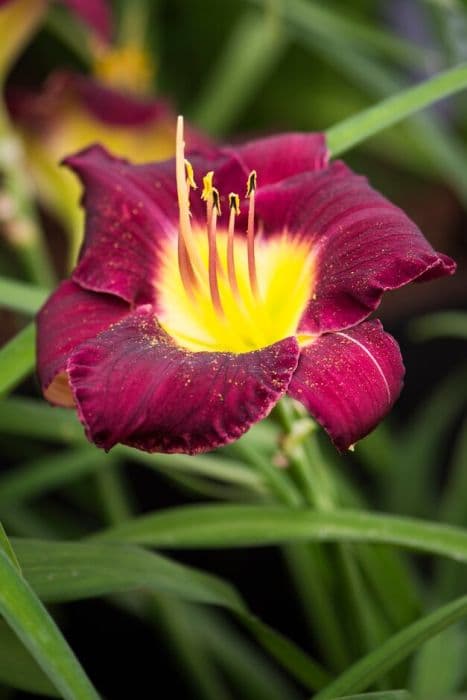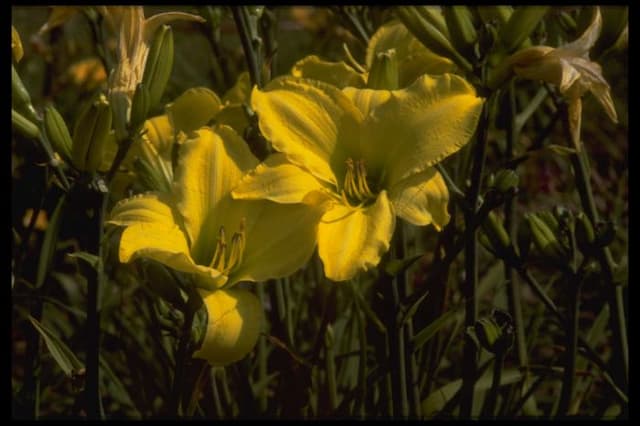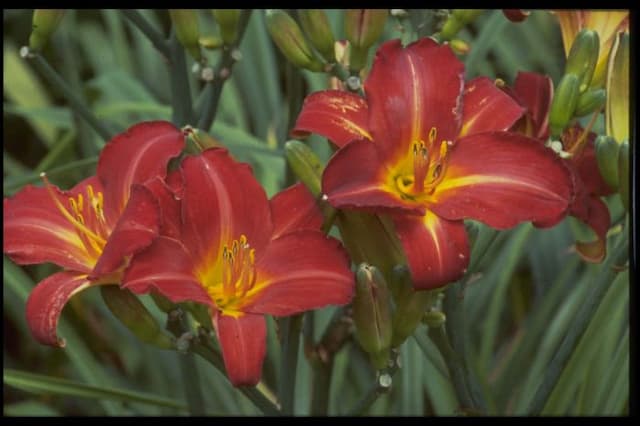Daylily Hemerocallis 'Serena Sunburst'

ABOUT
Hemerocallis 'Serena Sunburst', widely known as a daylily, is a perennial flower that brings color to gardens with its vibrant blossoms. This particular cultivar boasts blooms that exhibit a radiant blend of colors, with petals typically showcasing a gradient of bright yellows at their throats that seamlessly transition into a rich, fiery orange towards the edges, often resembling a sunburst pattern. The flowers are characterized by their trumpet-like shape and have a set of long, curling petals that splay outwards, giving the bloom a sense of movement and dynamism. The foliage of the daylily consists of long, slender leaves that are noticeably grass-like in their appearance. These leaves arch gracefully from the base of the plant, forming a fountain-like mound that provides a lush green backdrop for the striking flowers. Since the common name suggests, each lovely flower lasts for only a day, with new buds consistently opening to take the place of those that have wilted, ensuring a continuous display of floral beauty throughout the blooming period. Daylilies are known for their hardiness and ability to thrive under a variety of conditions, making them a popular choice for gardeners. They add a splash of warmth to any planting area with their sun-kissed hues and are often used in borders, as specimens, or even in mass plantings where their repeated patterns of bloom create a tapestry of color.
About this plant
 Names
NamesFamily
Hemerocallidaceae.
Synonyms
Daylily.
Common names
Hemerocallis 'Serena Sunburst'.
 Toxicity
ToxicityTo humans
The common name for Hemerocallis 'Serena Sunburst' is daylily. Daylilies are not generally considered toxic to humans, and in fact, many daylily species have edible parts. However, like any plant, individual allergies or sensitivities can occur. If a person is sensitive and ingests a part of the plant, they might experience mild stomach upset or an allergic reaction. Consumption of large quantities of the plant, especially if one is not used to it or if the plant is treated with chemicals, might lead to gastrointestinal discomfort.
To pets
For pets, specifically cats, daylilies are highly toxic. If a cat ingests any part of a daylily, it can cause severe kidney damage which might be fatal. Symptoms of poisoning in cats can include vomiting, lethargy, lack of appetite, and kidney failure. If a cat is suspected of having eaten any part of a daylily, it is crucial to seek immediate veterinary care as it can be a life-threatening situation. It is important to keep daylilies out of reach of cats to prevent accidental ingestion.
 Characteristics
CharacteristicsLife cycle
Perennials
Foliage type
Deciduous
Color of leaves
Green
Flower color
Yellow
Height
2 feet (0.61 meters)
Spread
2 feet (0.61 meters)
Plant type
Herb
Hardiness zones
Varies
Native area
Asia
Benefits
 General Benefits
General Benefits- Easy to Grow: Daylilies are known for their resilience and ability to flourish in a variety of soil conditions.
- Drought Tolerance: Once established, they can withstand periods of drought with minimal watering.
- Long Blooming: The 'Serena Sunburst' variety offers a long blooming season, providing color and interest in the garden over an extended period.
- Pest Resistance: Daylilies are generally resistant to many pests and diseases, requiring less intervention with chemicals.
- Attracts Pollinators: The vibrant flowers attract butterflies and bees, which are essential for pollination in the garden.
- Versatile Landscaping Plant: These plants can be used in borders, for mass plantings, or as a focal point in garden designs.
- Maintains Soil Health: Like other perennials, daylilies can help prevent soil erosion and promote a healthy garden ecosystem.
- Minimal Maintenance: Daylilies require very little maintenance once established, making them ideal for gardeners of all skill levels.
- Propagates Easily: They can be easily divided to propagate and share with others or to expand their presence in your garden.
- Seasonal Interest: They die back in winter, allowing for different seasonal planning and companion planting strategies.
 Medical Properties
Medical Properties- This plant is not used for medical purposes.
 Air-purifying Qualities
Air-purifying QualitiesThis plant is not specifically known for air purifying qualities.
 Other Uses
Other Uses- Daylily 'Serena Sunburst' petals can be used to add a pop of color to floral arrangements, complementing other flowers with its vibrant hues.
- The flowers of the daylily can be crystallized with sugar and used as edible decorations on cakes and desserts, adding both beauty and a subtle floral flavor.
- Daylily blooms can be used in handcrafted potpourris, contributing their color and a light, pleasant fragrance to the mixture.
- Pressed daylily flowers can be incorporated into art projects or crafts, such as bookmark-making, for a touch of natural beauty.
- The fibrous leaves of the daylily can be woven or braided to create natural garden ties for supporting other plants in the garden.
- Daylily plants can be used as a natural dye source, with the flowers producing shades of yellow or orange, depending on the mordant used.
- The sturdy stems of daylilies can provide support and structure when creating flower sculptures or living garden art pieces.
- Daylily buds, once dried, can be added to homemade potpourri blends, offering a unique textural element.
- Daylily flowers are sometimes used in educational settings to teach children about plant biology and the lifecycle of perennials through hands-on activities.
- The spent flowers and foliage of the daylily can be used as a natural mulch to suppress weeds and retain soil moisture in the garden.
Interesting Facts
 Feng Shui
Feng ShuiThe plant Daylily is not used in Feng Shui practice.
 Zodiac Sign Compitability
Zodiac Sign CompitabilityThe Daylily is not used in astrology practice.
 Plant Symbolism
Plant Symbolism- Daylily - The most common name for Hemerocallis 'Serena Sunburst' is Daylily. The daylily symbolizes motherhood and fertility due to its ability to produce an abundance of flowers.
- Transience - The name Hemerocallis comes from the Greek words for "day" and "beautiful," referring to the fact that each bloom typically lasts for only a day, symbolizing the fleeting nature of life.
- Rebirth - Since a single daylily plant can produce multiple flowers, it has also come to represent renewal and the continual cycle of birth, life, death, and rebirth.
- Forgetfulness - In the Victorian language of flowers, daylilies were associated with forgetfulness or a loss of memory, perhaps because the flowers fade away so quickly.
- Chinese Symbolism - In Chinese culture, daylilies are associated with forgetting worries and represent a mother's devotion to her children.
 Water
WaterDaylilies like the Hemerocallis 'Serena Sunburst' need to be watered deeply once a week, allowing for 1 to 1.5 gallons per plant during each session, ensuring that the soil is soaked to a depth of about 8 to 10 inches. During hot, dry periods, the frequency should be increased to twice a week. Always water early in the morning to allow foliage to dry before nightfall, as wet foliage can lead to fungal diseases. It’s important to avoid overhead watering to minimize the risk of leaf spot diseases. Mulching can also help retain soil moisture and reduce the frequency of watering.
 Light
LightDaylilies like the Hemerocallis 'Serena Sunburst' thrive in full sun to partial shade. They prefer a minimum of 6 hours of direct sunlight daily but can tolerate some light afternoon shade, especially in hot climates. Plant them in a location that gets consistent light throughout the day for optimum flower production.
 Temperature
TemperatureDaylilies such as the Hemerocallis 'Serena Sunburst' are quite hardy and can survive in temperatures ranging from as low as -20°F to as high as 90°F; however, they bloom best when day temperatures are between 70°F and 90°F. Protect them from extreme cold by mulching in the fall, and ensure they have proper ventilation to prevent overheating during peak summer heat.
 Pruning
PruningDaylilies like the Hemerocallis 'Serena Sunburst' should be deadheaded regularly to remove spent blooms and encourage new flowers. Trim back the foliage in late summer after blooming has finished to encourage healthy new growth. Cut the foliage down to the ground in late fall to prepare the plant for winter and prevent disease.
 Cleaning
CleaningAs needed
 Soil
SoilDaylilies, including Hemerocallis 'Serena Sunburst', thrive in well-draining soil with a slightly acidic to neutral pH between 6.0 and 7.0. A good soil mix would be one part loam, one part peat moss or compost, and one part perlite or sand to ensure good drainage.
 Repotting
RepottingDaylilies typically do not need frequent repotting as they are often grown outdoors. However, if grown in containers, they should be repotted every 3 to 4 years to refresh the soil and give them more room to grow.
 Humidity & Misting
Humidity & MistingDaylilies are tolerant of a wide range of humidity levels and do not have specific humidity requirements, making them versatile for various outdoor environments.
 Suitable locations
Suitable locationsIndoor
Ensure bright light and good air circulation for indoor Daylilies.
Outdoor
Plant in full sun to partial shade in well-draining soil.
Hardiness zone
3-9 USDA
 Life cycle
Life cycleThe life of the Hemerocallis 'Serena Sunburst', commonly known as a Daylily, begins with seed germination, where the seed requires a period of stratification to break dormancy. Following germination, the seedling grows into a juvenile plant, developing a root system and foliage in the form of slender, arching leaves. As the Daylily matures, it forms a clump with multiple shoots through vegetative reproduction and can also be propagated by division. The growth phase is characterized by the development of scapes, which are leafless stems that bear the flower buds. The flowers bloom in mid to late summer, typically lasting just a day each, after which they are followed by the formation of seed pods if pollination occurs. Finally, the Daylily enters a period of dormancy during the colder months, with growth and flowering resuming in the following growing season.
 Propogation
PropogationPropogation time
Spring-Early Summer
The Hemerocallis 'Serena Sunburst', commonly known as the Daylily, is typically propagated through division, which is the most popular method for this plant. This is best done in early spring or immediately after the plant finishes flowering in late summer to early fall. Division involves carefully digging up the clump of the plant with a shovel, making sure to keep a generous amount of soil around the roots to reduce stress. Once the clump is excavated, gardeners can use their hands or a sharp knife to divide the clump into smaller sections, ensuring that each new section has at least one fan of leaves and a portion of the root system. These divisions are then replanted immediately at the same soil depth they were previously growing, and they should be watered thoroughly to help re-establish the new plants.









